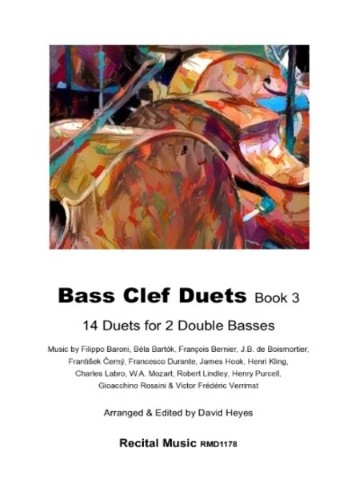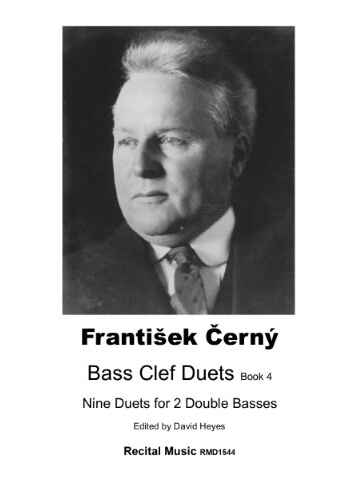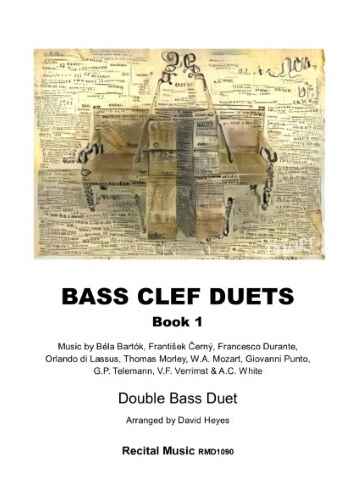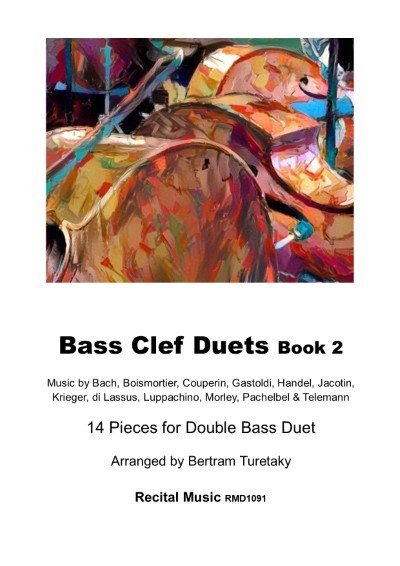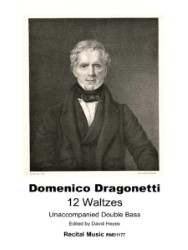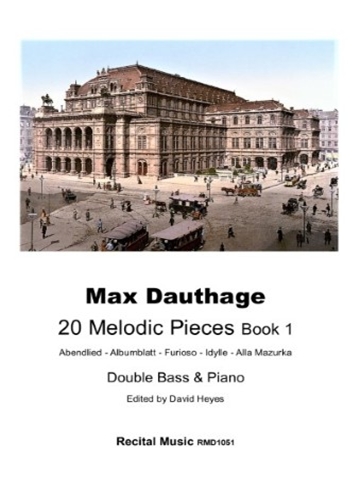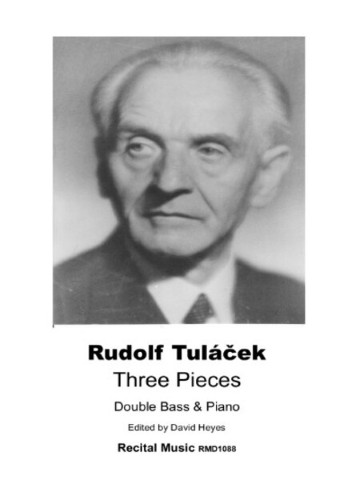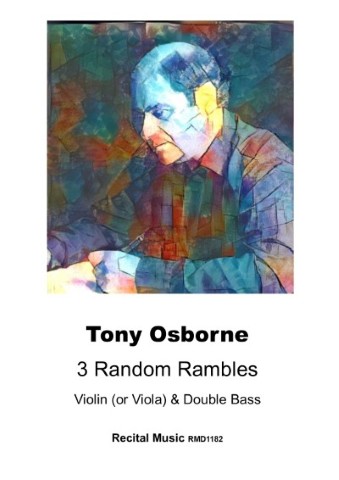Description
Bass Clef Duets Book 3 brings together 14 engaging and accessible double bass duets from the 16th to 20th-century. Edited and arranged by David Heyes, the duets …are ideal as sight-reading music for the teacher and student, or as fun pieces to play with friends, and as accessible and inventive repertoire to play in recital and concerts, suitable for any audience or occasion.
Each piece has been carefully selected and edited, bringing together fourteen composers, featuring four original double bass duets and ten transcriptions.
The edition includes a score and two solo parts for ease of performance.
1. W.A. Mozart (1756-1791) – Allegro
This short duet is the eighth of twelve duets (K.487), originally for 2 French Horns also arranged for basset horns and for many instrumental combinations. Composed in 1786, each duet is short and succinct, in a range of tempos and dance forms, and transcribe beautifully for double bass duet.
2. František Černý (1861-1940) – Larghetto (Study No.123)
Transposed a fifth higher than the original, this duet was originally included in Černý’s Method for Double Bass (1906) and emphasises the lyrical and sonorous qualities of the double bass in the orchestral register of the instrument.
3. J.B. de Bosimortier (1689-1755) – Légèrement (Sonata No.1)
Boismortier was a French baroque composer and this duet is originally for 2 bassoons and was composed in 1726. Sonata No.1 is in G major, transposed a fourth higher in this transcription, and Légèrement is the fourth and final movement. It includes canonic invention and contrapuntal writing for both basses, also playing in thirds.
4. Victor Frédéric Verrimst (1825-1893) – Lesson No.1
Verrimst studied double bass at the Paris Conservatoire, where he also became Professor of Double Bass alongside his role as Solo Bassist at the Opéra de Paris. This duet, transposed a fifth higher than the original, was included in Solfège du Contre-Bassiste Op.129 and was composed in 1885. Bass1 was intended to be played by the student and bass 2 by the teacher.
5. Filippo Baroni (1660-1716) – Primo Canone à 2. all’unisono
This vocal canon, taken from Canoni a due voci, is playable by any combination of bass clef instruments. Baroni’s book of vocal canons was published in Bologna in 1704 but very little is known about the composer. The canon is effective and ideal for study or concert use.
6. Robert Lindley (1776-1855) – Rondo
Cellist and composer Robert Lindley was a great friend of Domenico Dragonetti (1763-1846), and was described as “probably the greatest violoncellist of his time”. Rondo is originally for ‘cello and bass’, usually a solo cello accompanied by a 2nd cello, and is the second movement from Solo No.1. The piece is lively and entertaining, with something of interest for both bassists.
7. James Hook (1746-1827) – Duetto No.1
Originally for two cellos, the first movement of Duetto No.1 Op.58 has been transposed a fifth higher in this edition. James Hook was an English composer and organist who produced a wealth of stage, vocal and instrumental music which was popular in his lifetime. Duetto No.1 is elegant and stylish, and typical of the music of the late 18th-century.
8. Charles Labro (1810-1882) – Lesson No.11
Labro taught at the Paris Conservatoire for many years and composed a series of works for his students, alongside a Method (1860) and several concertos. Lesson No.11 is taken from his Méthode de contre-basse Op.119 and the original edition suggests that the second part can be played by double bass or viola. The sections are contrasting and inventive, with musical and technical challenges for each player
9. Francesco Durante (1684-1755) – Fugue in C major
Durante was a Neapolitan composer and in 1742 succeeded Nicola Porpora as head of the Conservatorio di Santa Maria di Loreto in Naples. He was considered one of the best church composers of his style and period, producing an impressive body of sacred and instrumental music. The Fugue in C major is unlikely to be an original work for double bass duet and it appeared in several late 19th-century double bass methods, but in a lower key.
10. Henry Purcell (1659-1695) – When Gay Philander Left the Plain
Henry Purcell is regarded as one of England’s greatest composers and his choral and instrumental music is performed extensively by musicians across the world to this day. This two-part song, for treble or tenor and bass. was first published in 1684 and would probably have been performed with continuo accompaniment but works equally well as a duet
11. François Bernier (1814-1881) – Finale
Bernier was Professor of double bass at the Royal Brussels Conservatoire in Belgium. His Méthode de Contre-Basse was published by Schott around 1864 and the majority of technical exercises and scales are written for double bass with the accompaniment of a second bass. Finale is the final work in the book and is an interesting and inventive duet for two progressing bassists. It could be played an octave higher by more advanced bassists.
12. Gioacchino Rossini (1792-1868) – Menuet (Duet No.2)
Rossini composed 39 operas and retired at the age of 37. He composed a number of instrumental works over the years including 5 Duets for 2 Natural Horns in around 1806. Each duet is short, inventive, tuneful and accessible and No.2 (Menuet) transcribes well for double basses. There are few challenges and the piece could easily be repeated in full, with bassists changing parts, to extend its duration.
13. Béla Bartók (1881-1945) – Ruthenian Song
Bartók is considered one of the most important composers of the 20th-century. He composed a wealth of music in most genres, including music for young musicians, often based on folk songs, which is still at the heart of the educational repertoire today. His 44 Duos for two violins were composed in 1931 and Ruthenian Song is taken from Book 1. Recital Music also publish a book of duos and trios by Bartók, arranged for double basses by David Heyes.
14. Henri Kling (1842-1918) – Tempo di Valse (Duet No.7)
Kling, born in Paris, was a solo hornist, teacher, composer, conductor, organist and writer, composing a wealth of music for the French Horn. His 30 Duets for 2 Horns were published around 1880 and each duet is short and succinct, full of character and spirit, and none outstaying their welcome. Tempo Di Vale is stylish and elegant and could be repeated to extend its duration.
About Editor and Arranger David Heyes:
David Heyes (b.1960) studied double bass with Laurence Gray and Bronwen Naish, later at the Royal College of Music in London, and completed his post-graduate studies in Prague with František Pošta (Principal Bass, Czech Philharmonic Orchestra). He has given recitals and masterclasses in 20 countries over the past few years and has been a juror at a number of international competitions, three times as chairman.
David’s collaborative work gained him a prestigious award from the David Walter Charitable Trust of New York for his pioneering activities as a soloist, teacher, publisher, and commissioner of new music for double bass and he works with composers throughout the world to expand the double bass repertoire by commissioning new music and by rediscovering forgotten ones. Since 1983 more than 700 works have been written for him, music from one to twenty basses and from beginner to virtuoso, and he has premiered ten contemporary concertos with orchestra.
David began to compose in 2013 and has had music performed and recorded in 29 countries across five continents. He is a D’Addario Performing Artist and has recently commissioned a solo double bass from British master-luthier Martin Penning.

